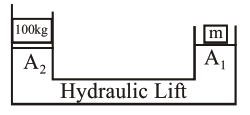A hydraulic press can lift $100 \mathrm{~kg}$ when a mass 'm' is placed on the smaller piston. It can lift $\mathrm{kg}$ when the diameter of the larger piston is increased by 4 times and that of the smaller piston is decreased by 4 times keeping the same mass ' $m$ ' on the smaller piston.
Using Pascals law

$\frac{100 \times \mathrm{g}}{\mathrm{A}_{2}}=\frac{\mathrm{mg}}{\mathrm{A}_{1}}$...(1)
Let $m$ mass can lift $\mathrm{M}_{0}$ in second case then
$\frac{\mathrm{M}_{0} \mathrm{~g}}{16 \mathrm{~A}_{2}}=\frac{\mathrm{mg}}{\mathrm{A}_{1} / 16}$...(2)
$\left\{\right.$ Since $\left.A=\frac{\pi \mathrm{d}^{2}}{4}\right\}$
From equation (1) and (2) we get
$\frac{\mathrm{M}_{0}}{16.100}=16$
$\Rightarrow \mathrm{M}_{0}=25600 \mathrm{~kg}$
Click here to get exam-ready with eSaral
For making your preparation journey smoother of JEE, NEET and Class 8 to 10, grab our app now.
